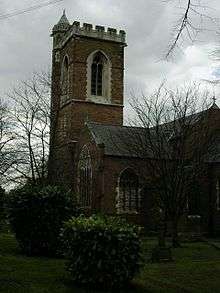St Saviour's Church, Saltley
| St Saviour's | |
|---|---|
 St Saviour’s Church, Saltley | |
| 52°29′10.44″N 1°51′30.91″W / 52.4862333°N 1.8585861°WCoordinates: 52°29′10.44″N 1°51′30.91″W / 52.4862333°N 1.8585861°W | |
| Location | Saltley Birmingham |
| Country | England |
| Denomination | Church of England |
| Churchmanship | Anglo-catholic |
| History | |
| Dedication | St Saviour |
| Architecture | |
| Heritage designation | Grade II listed |
| Architect(s) | Richard Charles Hussey |
| Completed | 1850 |
| Construction cost | £6,000 |
| Specifications | |
| Capacity | 810 people |
| Administration | |
| Parish | St Mark with St Saviour, Saltley |
| Deanery | Aston |
| Archdeaconry | Birmingham |
| Diocese | Anglican Diocese of Birmingham |
St Saviour's Church, Saltley is a Grade II listed parish church in the Church of England in Birmingham.[1]
History
The foundation stone was laid on Tuesday 24 October 1848.[2] A brass plate was attached to the foundation stone with the inscription:
This first stone of the Church at Saltley, in the parish of Aston juxta Birmingham, was laid by the Right Hon Lord Littleton on the 24th day of October 1848. Charles Bowyer Adderley, Esq., patron; Richard Charles Hussey, architect; Charles Branston, Edward Gwyther, contractors.
It was built as a Commissioners' church with a grant of £300. Another £500 was donated by Joseph Wright, and the remainder was funded by Charles Adderley, 1st Baron Norton to cover the £6,000 cost. The church was consecrated on 28 July 1850[3] by James Prince Lee the Bishop of Manchester (in the absence of Henry Pepys the Bishop of Worcester).[4]
The tower was added in 1871.
Organ
The church contained an organ by Halmshaw. A specification of the organ can be found on the National Pipe Organ Register.[5]
References
- ↑ The Buildings of England. Warwickshire. Nikolaus Pevsner. p.201. Second Edition. 1966. Penguin Books Limited
- ↑ Aris’s Birmingham Gazette. Monday 30 October 1848. p.2. New Church at Saltley
- ↑ Aris’s Birmingham Gazette. Monday 29 July 1850. p.1. The New Church of St Saviour at Upper Saltley.
- ↑ Worcestershire Chronicle. Wednesday 31 July 1850. p.4. Local News
- ↑ "NPOR D02629". National Pipe Organ Register. British Institute of Organ Studies. Retrieved 14 February 2015.
External links
Historic England. "Details from listed building database (1076176)". National Heritage List for England.